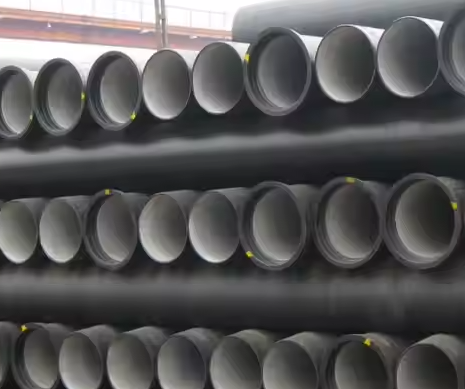Ductile iron, also known as nodular or spheroidal graphite iron, is inherently magnetic due to its high iron content and ferromagnetic matrix structure. Its magnetic behavior—characterized by relative permeability, saturation induction, and hysteresis loss—is influenced by factors such as graphite morphology, matrix microstructure (ferritic vs. pearlitic), and heat treatment. Typical grades like ASTM A536 65-45-12 exhibit moderate permeability (~290 at 5,000 Gauss), whereas pearlitic or higher-carbon grades can reach greater permeability levels. Understanding these properties is crucial for applications ranging from induction cookware to electromagnets and sensor housings. This guide provides an in-depth look at why ductile iron is magnetic, quantitative magnetic data, practical testing methods, and answers to frequently asked questions—all optimized for SEO and international readability.

Introduction
Ductile iron is a cast iron alloy distinguished by its nodular graphite inclusions, which grant superior ductility and impact resistance compared to gray cast iron. Despite these mechanical enhancements, ductile iron retains the ferromagnetic nature of iron, making it responsive to magnetic fields and usable in applications requiring magnetic interactions.
Is Ductile Iron Magnetic?
Yes, ductile iron is magnetic. As a ferrous material, it contains predominantly iron atoms with unpaired electrons that align under an external magnetic field, producing a net magnetic moment. The presence of spheroidal graphite nodules does not disrupt its basic ferromagnetism; instead, the continuous iron matrix maintains strong magnetic characteristics similar to cast steel.
Factors Affecting Magnetism
Graphite Morphology and Microstructure
-
Nodular Graphite: In ductile iron, graphite appears as discrete spheres, which minimally impede magnetic domain movement compared to the flaky graphite in gray iron.
-
Ferritic vs. Pearlitic Matrix: Ferritic ductile irons are magnetically softer, exhibiting higher permeability and lower hysteresis loss; pearlitic grades show slightly reduced permeability but increased strength.
Alloying Elements
-
Elements like silicon, manganese, and magnesium influence grain structure and can subtly alter magnetic properties by affecting domain wall mobility.
Heat Treatment
-
Processes such as annealing, austempering, or quenching can refine microstructure, affecting both mechanical and magnetic responses. For instance, austempered ductile irons (ADIs) show variable magnetic behavior depending on austempering temperature and resulting phase fractions.
Magnetic Properties Data
| Grade | Relative Permeability @5,000 Gauss | Saturation Induction @10,000 Oe | Hysteresis Loss (erg/cm³/cycle) |
|---|---|---|---|
| ASTM A536 65-45-12 | 290 | – | 5 |
| ASTM A536 100-70-03 | 570 | 17,600 Gauss | 30 |
| Cast Steel (solid) | 2,100 | 18,000 Gauss | 5 |
| Gray Iron (60-40-18) | 2,100 | 18,000 Gauss | 5 |
Data adapted from Daycounter’s comparative study of ductile iron and other cast materials.
Applications
-
Induction Cookware: Ductile iron pans rely on magnetic permeability for efficient induction heating, making grades like 65-45-12 popular for high-performance cookware.
-
Electromagnets & Sensors: The combination of mechanical strength and magnetism enables use in magnetic assemblies, rotor housings, and sensor frames where durability and magnetic response are both critical.
-
Piping & Valves: Magnetic detectability of ductile iron pipes aids leak detection and nondestructive testing in water and sewage systems.
Testing Magnetism
-
Simple Magnet Test: Bring a strong permanent magnet in contact with the ductile iron surface—magnetic attraction confirms ferromagnetism.
-
BH Curve Measurement: Use a gaussmeter and a controlled magnetizing coil to plot flux density (B) vs. magnetizing force (H), determining permeability and saturation characteristics.
-
Hysteresis Loop Analysis: Evaluate energy loss per cycle by measuring the area within the hysteresis loop, informing material selection for dynamic magnetic applications.
FAQ
Q1: Is ductile iron more magnetic than gray iron?
A1: Gray iron typically shows higher permeability (~2,100) compared to common ductile grades (~290–570) because its flake graphite structure allows more domain wall pinning at moderate fields.
Q2: Can ductile iron be used on induction stovetops?
A2: Absolutely—its ferromagnetic nature and good thermal properties make ductile iron cookware well-suited for induction cooking.
Q3: How does heat treatment affect ductile iron’s magnetism?
A3: Heat treatments like austempering alter the ferrite/austenite balance, modifying permeability and hysteresis; ferritic ADIs are softer magnets with higher permeability, while more martensitic structures reduce permeability.
Q4: What is the typical relative permeability range for ductile iron?
A4: Depending on grade and treatment, ductile iron’s relative permeability at 5,000 Gauss ranges from ~290 to ~570.
Q5: Are there non-magnetic cast irons?
A5: White cast iron and certain high-alloy irons can exhibit very low permeability, but nearly all traditional cast irons remain at least moderately ferromagnetic.

